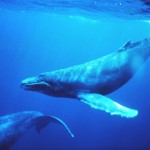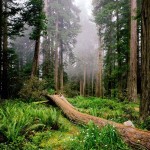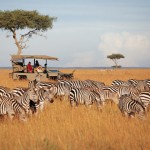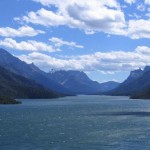Archive for March, 2010
-
Humpbacked Whales of Hawaii
Posted in Australia & Pacific | March 17, 2010 The 1960s and 70s saw the first signs of danger to the species of the biggest animals in the world. I am talking about none other than the humpbacked whales. This was the time when commercial hunting was amply prevalent. It seemed to me as if our children would never lay their eyes on a whale again. The world stood in danger of losing its natural wonder. But, this was not to be the case. Therefore, the ‘Au’au Channel that lies between the Hawaii islands of Maui and Lāna’i is home to these mammoth, majestic giants. Humpback whales can weigh up to 45 tons. These whales rise and spout anywhere and everywhere. They roll in spiral movements and slap the water with their fins and tails. I was spellbound to see their movements. It is common [...]
The 1960s and 70s saw the first signs of danger to the species of the biggest animals in the world. I am talking about none other than the humpbacked whales. This was the time when commercial hunting was amply prevalent. It seemed to me as if our children would never lay their eyes on a whale again. The world stood in danger of losing its natural wonder. But, this was not to be the case. Therefore, the ‘Au’au Channel that lies between the Hawaii islands of Maui and Lāna’i is home to these mammoth, majestic giants. Humpback whales can weigh up to 45 tons. These whales rise and spout anywhere and everywhere. They roll in spiral movements and slap the water with their fins and tails. I was spellbound to see their movements. It is common [...] -
One Day in the Life of a Jaguar
Posted in South America | March 17, 2010 Have you seen a jaguar rise from his sleep sensing danger? I had the fortune of seeing one when I was in Costa Rica. In my case, it was a young male jaguar rising from his deep rest. He stretches elegantly and leaves the place of his birth forever. Shelter is not scarce here. There is plenty of deer, peccaries, and agoutis available for food. Our young male jaguar has also probably sensed the presence of females with whom he may possibly mate. However, the presence of an adult male jaguar serves as a deterrent. It is not likely that the older one would welcome rivals. The young male jaguar is no longer under the influence of his protective mother. The scent of his mother no longer lingers in the air. There is no reason for him to cling to his [...]
Have you seen a jaguar rise from his sleep sensing danger? I had the fortune of seeing one when I was in Costa Rica. In my case, it was a young male jaguar rising from his deep rest. He stretches elegantly and leaves the place of his birth forever. Shelter is not scarce here. There is plenty of deer, peccaries, and agoutis available for food. Our young male jaguar has also probably sensed the presence of females with whom he may possibly mate. However, the presence of an adult male jaguar serves as a deterrent. It is not likely that the older one would welcome rivals. The young male jaguar is no longer under the influence of his protective mother. The scent of his mother no longer lingers in the air. There is no reason for him to cling to his [...] -
Redwood National Park: Land of Tallest trees
Posted in North America | March 16, 2010 In early morning, as the fog caresses the tress, as you stand in the misty shadows of vast redwood forests, sustaining, flourishing in lush and humid climate along the Pacific coast. Gazing, glaring and having a glimpse of past at Earth’s Tallest living things. The trees took the blunt and axe from loggers, and were badly threatened by logging. Once covering over two million acres of land from final ice age, tress after trees were fallen with a windswept force. Redwood National Park near the northern limit of redwood’s slender range of the coat, preserving the remnants of a forest. Massive redwood trees, can live for some 2000 years, grows to the heights up to 367 feet, and the base of trunk can be as wide as 22 feet. With a joint venture [...]
In early morning, as the fog caresses the tress, as you stand in the misty shadows of vast redwood forests, sustaining, flourishing in lush and humid climate along the Pacific coast. Gazing, glaring and having a glimpse of past at Earth’s Tallest living things. The trees took the blunt and axe from loggers, and were badly threatened by logging. Once covering over two million acres of land from final ice age, tress after trees were fallen with a windswept force. Redwood National Park near the northern limit of redwood’s slender range of the coat, preserving the remnants of a forest. Massive redwood trees, can live for some 2000 years, grows to the heights up to 367 feet, and the base of trunk can be as wide as 22 feet. With a joint venture [...] -
Safari in Kenya: Iconic Wildlife destination
Posted in Africa | March 15, 2010 Africa once known as ‘dark continent’ in it lies the magical beacon of iconic wildlife destination which is none other then the enchanting and spectacular landscape with unspoiled natural surroundings in wildlife. There is no where else on earth that can offer such a great combination of Safari other then Kenya which has mountains, beaches, coral reefs, wildlife and local rich cultures, traditions and customs of old age Masai community along with breathtaking sceneries of the sun rising and setting over mountain peaks, all so much diverse and all together in a platter that will entice and enthrall you. Kenya, history says, here were man’s earliest ancestors may have originated in Turkana which is Northern Kenya some five million years [...]
Africa once known as ‘dark continent’ in it lies the magical beacon of iconic wildlife destination which is none other then the enchanting and spectacular landscape with unspoiled natural surroundings in wildlife. There is no where else on earth that can offer such a great combination of Safari other then Kenya which has mountains, beaches, coral reefs, wildlife and local rich cultures, traditions and customs of old age Masai community along with breathtaking sceneries of the sun rising and setting over mountain peaks, all so much diverse and all together in a platter that will entice and enthrall you. Kenya, history says, here were man’s earliest ancestors may have originated in Turkana which is Northern Kenya some five million years [...] -
Yellowstone National Park: Fabulous nature’s gift
Posted in North America | March 15, 2010 America’s first National Park- Yellowstone National Park, fabulous nature’s gift, Wyoming’s flagship attractions, and a natural cornucopia. In brimming sun, with perfect blue sky and mountains sticking and rising high up as background Yellowstone National Park is amazing destination for exploring the plethora of nature, wildlife, geology and loads of adventure and thrill seeking adventures. Well growth is the factor, and Mother Nature is taking good care out here, with growing mammals, shaggy grizzlies, giant moose, wolverine packed wolves, and superfluity of ecosystems with motley concentrations of immense wildlife. Home of world’s half of the geysers, abundance of alpine lakes, riveting rivers and mesmeric waterfalls. As you explore [...]
America’s first National Park- Yellowstone National Park, fabulous nature’s gift, Wyoming’s flagship attractions, and a natural cornucopia. In brimming sun, with perfect blue sky and mountains sticking and rising high up as background Yellowstone National Park is amazing destination for exploring the plethora of nature, wildlife, geology and loads of adventure and thrill seeking adventures. Well growth is the factor, and Mother Nature is taking good care out here, with growing mammals, shaggy grizzlies, giant moose, wolverine packed wolves, and superfluity of ecosystems with motley concentrations of immense wildlife. Home of world’s half of the geysers, abundance of alpine lakes, riveting rivers and mesmeric waterfalls. As you explore [...] -
Wildlife conservation in India: Nature is missing its glory
Posted in Asia | March 15, 2010 Nature is the major part that gave plenty of chances to flourish mankind. When it comes about doing justice, it’s all what nature do, but not us. We learnt from childhood to save others, to think for others first, and rest all the things. In fact, we are living all because of the nature. And when our turn came to save the nature, we are simply sitting back, relaxing as if nothing has happened. Therefore, the government of India started giving advertisements to save the nature or in easy language ‘Save Wildlife’. Many wildlife organizations are there who try to save and flourish the wildlife. Many natural projects and programmes have been undertaken by the Indian Government like Project Tiger, Nature Camps, and Jungle Lodges. These have [...]
Nature is the major part that gave plenty of chances to flourish mankind. When it comes about doing justice, it’s all what nature do, but not us. We learnt from childhood to save others, to think for others first, and rest all the things. In fact, we are living all because of the nature. And when our turn came to save the nature, we are simply sitting back, relaxing as if nothing has happened. Therefore, the government of India started giving advertisements to save the nature or in easy language ‘Save Wildlife’. Many wildlife organizations are there who try to save and flourish the wildlife. Many natural projects and programmes have been undertaken by the Indian Government like Project Tiger, Nature Camps, and Jungle Lodges. These have [...] -
Haleakala National Park
Posted in North America | March 14, 2010 Haleakala national park stretches across east Maui. The park is home Haleakala Crater, which is an active volcano that not does erupt presently. It is also the highest peak in Maui. The magnificent slopes of Haleakala rise more than 10,000 feet above sea level. They can be seen from any point in the island. The word Haleakala means ‘house of the sun’ in Hawaiian. According to legend, the demigod Maui lassoed the sun from the summit to slowdown the journey of the sun across the skies. Haleakala National Park comprises an unbelievable range of natural environments. Reaching the peaks of Haleakala Crater is a popular tourist activity. You also get the opportunity to walk above the clouds. Hiking across the diverse landscapes, deserts, and [...]
Haleakala national park stretches across east Maui. The park is home Haleakala Crater, which is an active volcano that not does erupt presently. It is also the highest peak in Maui. The magnificent slopes of Haleakala rise more than 10,000 feet above sea level. They can be seen from any point in the island. The word Haleakala means ‘house of the sun’ in Hawaiian. According to legend, the demigod Maui lassoed the sun from the summit to slowdown the journey of the sun across the skies. Haleakala National Park comprises an unbelievable range of natural environments. Reaching the peaks of Haleakala Crater is a popular tourist activity. You also get the opportunity to walk above the clouds. Hiking across the diverse landscapes, deserts, and [...] -
Waterton National Park
Posted in Europe | March 13, 2010 The Waterton National Park was created in the year 1895. It is spread across 140 square kilometers. The park is fourth of its kind in Canada and one of the smallest in the Canadian Rockies. The size of the park has varied over the year. Presently, it occupies 505 square kilometers of land. There have been an increasing number of recommendations to include the Waterton lakes in the park area. This has been done mainly to ensure conservation. The park gets its name from the lakes. The chain of lakes was named by Lieutenant Blakiston in honor of British naturalist, Squire Charles Waterton. Waterton National Park is representative of the southern Rocky Mountains Natural Region. Here, the ancient Rocky Mountains meet the prairie lands. The landscape [...]
The Waterton National Park was created in the year 1895. It is spread across 140 square kilometers. The park is fourth of its kind in Canada and one of the smallest in the Canadian Rockies. The size of the park has varied over the year. Presently, it occupies 505 square kilometers of land. There have been an increasing number of recommendations to include the Waterton lakes in the park area. This has been done mainly to ensure conservation. The park gets its name from the lakes. The chain of lakes was named by Lieutenant Blakiston in honor of British naturalist, Squire Charles Waterton. Waterton National Park is representative of the southern Rocky Mountains Natural Region. Here, the ancient Rocky Mountains meet the prairie lands. The landscape [...] -
Kruger National Park
Posted in Africa | March 12, 2010 Kruger National Park lies in the heart of Lowveld. This wildlife sanctuary cannot be paralleled. The atmosphere at the park is unique. The wilderness seems to have no boundaries. Experience true African wildlife while at the park. Kruger National Park is the largest game reserve of South Africa. The park is larger than Israel. It is spread over 2 million hectares of land and stretches for 352 km from north to south, along the border of Mozambique. The wildlife experience is sure to touch your heart. The park serves as the flagship for the national parks in the country. It gives you the ultimate African safari experience. It lies across the provinces of Mpumalanga and Limpopo, which lie to the north of the country. It is now part of the Great [...]
Kruger National Park lies in the heart of Lowveld. This wildlife sanctuary cannot be paralleled. The atmosphere at the park is unique. The wilderness seems to have no boundaries. Experience true African wildlife while at the park. Kruger National Park is the largest game reserve of South Africa. The park is larger than Israel. It is spread over 2 million hectares of land and stretches for 352 km from north to south, along the border of Mozambique. The wildlife experience is sure to touch your heart. The park serves as the flagship for the national parks in the country. It gives you the ultimate African safari experience. It lies across the provinces of Mpumalanga and Limpopo, which lie to the north of the country. It is now part of the Great [...] -
Biscayne National Park
Posted in North America | March 12, 2010 Most travelers when they hear of a national park in South Florida think of the Everglades. However, within a few miles there is another national park: Biscayne National Park. This park is located along the southeast coast of Florida, just south of Miami. The park is spread over 181,500 acres. The park comprises a section of the mainland and large portions of Biscayne Bay. The barrier islands off the coast, too, are part of the national park. Biscayne National Park is famous for the blue waters of the bay. The coral reefs and marine life are highlights of the park. There are plenty of sea birds and subtropical vegetation. Trails are present on the islands and the mainland. The park is just 30 miles away from downtown Miami. It comprises the [...]
Most travelers when they hear of a national park in South Florida think of the Everglades. However, within a few miles there is another national park: Biscayne National Park. This park is located along the southeast coast of Florida, just south of Miami. The park is spread over 181,500 acres. The park comprises a section of the mainland and large portions of Biscayne Bay. The barrier islands off the coast, too, are part of the national park. Biscayne National Park is famous for the blue waters of the bay. The coral reefs and marine life are highlights of the park. There are plenty of sea birds and subtropical vegetation. Trails are present on the islands and the mainland. The park is just 30 miles away from downtown Miami. It comprises the [...]


